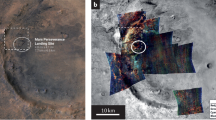Abstract
Replying to: R. Arculus, I. H. Campbell, S. M. McLennan & S. R. Taylor Nature 459 10.1038/nature08077 (2009)
Arculus et al.1 raise an important question regarding the use of terrestrial rock nomenclature to characterize extraterrestrial materials. Here the issue relates to the definition of ‘andesite’, and whether the felsic achondrite meteorites GRA 06128 and GRA 06129 (GRA 06128/9) can and should be classified using this term2. More broadly, the question is whether extraterrestrial rocks should be classified using standard petrologic and geochemical criteria, such as mineralogy and major-element bulk composition, developed for the description of terrestrial rocks3,4. The approach of Arculus et al.1 is that petrogenetic process is of equal or greater importance when classifying a rock. This question must ultimately be decided by the scientific community.
Similar content being viewed by others
Main
Examples of the difficulties associated with extraterrestrial rock nomenclature are numerous in planetary petrology. Materials derived from the lunar maria are termed ‘basalt’ despite enormous diversity in their trace-element compositions, and have a different mode-of-origin as compared to terrestrial basalts5. Furthermore, meteoritic ‘basalts’ from Mars and from the asteroid belt (basalt is a term used by Arculus et al.1 to describe the eucrites) carry with them no inference that they formed under the same petrogenetic conditions as terrestrial basalts. Similarly, 3.9 to 4.4-Gyr-old lunar felsites displaying dry mineral assemblages have been commonly termed ‘granites’6, despite some opinion that granite can only form in water-rich environments7. The Moon is also populated by norite, gabbro, anorthosite, troctolite, granulite and so forth5, all of which are nomenclature terms used to describe terrestrial rocks and whose lunar genesis differs from their terrestrial counterparts.
Terrestrial andesite is commonly defined using two classification schemes from the International Union of Geological Sciences3,4. First, with a petrological classification, as a rock chiefly composed of plagioclase feldspar with subordinate accessory minerals, such as pyroxene, olivine or hornblende. Second, using the chemical classification as shown in Fig. 1 of our paper2. GRA 06128/9 qualify as andesite using either of these classifications. The rare-earth elements (REEs) and other lithophile trace elements have not commonly been used to define terrestrial or extra-terrestrial rocks, as suggested by Arculus et al.1; however, we acknowledge that these elements are important petrogenetic indicators.
We suggest that some asteroids may have crustal material that shares compositional and mineralogical similarities with the Earth’s average continental crust, but we do not suggest a similar mechanism for its generation2. The generation of GRA 06128/9 is probably not plate tectonics, but through low degrees of partial melting of a relatively undifferentiated asteroidal body, as we demonstrated, and for which the Re–Os and oxygen isotope, age and platinum-group element data provide important evidence. This process may have been an important mechanism for evolved crust formation in the early Solar System2. Indeed, if rocks with andesitic compositions are discovered on planetary bodies other than Earth (for example, Mars or asteroids), they might have origins that differ from terrestrial andesites, which are commonly products of water-charged subduction processes.
Given the prior applications of terrestrial rock nomenclature to extraterrestrial rocks, as well as the common petrologic and geochemical definitions of the term andesite, we believe it is an appropriate term to use to describe the achondrites GRA 06128/9.
References
Arculus, R., Campbell, I. H., McLennan, S. M. & Taylor, S. R. Asteroids and andesites. Nature 459, 10.1038/nature08077 (2009).
Day, J. M. D. et al. Early formation of evolved asteroidal crust. Nature 457, 179–182 (2009)
Le Maitre, R. W. A Classification of Igneous Rocks and Glossary of Terms: Recommendations of the International Union of Geological Sciences Subcommission on the Systematics of Igneous Rocks (Blackwell Scientific, 1989)
Le Bas, M. J. & Streckeisen, A. L. The IUGS systematics of igneous rocks. J. Geol. Soc. Lond. 148, 825–833 (1991)
Jolliff, B. L., Wiezorek, M. A., Shearer, C. K. & Neal, C. R. (eds) New Views of the Moon (Reviews in Mineralogy and Geochemistry, Vol. 60, Mineralogical Society of America, 2006)
Bonin, B., Bébien, J. & Masson, P. Granite: a planetary point of view. Gondwana Res. 5, 261–273 (2002)
Campbell, I. H. & Taylor, S. R. No water, no granites — no oceans, no continents. Geophys. Res. Lett. 10, 1061–1064 (1983)
Author information
Authors and Affiliations
Rights and permissions
About this article
Cite this article
Day, J., Ash, R., Liu, Y. et al. Day et al. reply. Nature 459, E2 (2009). https://doi.org/10.1038/nature08078
Issue Date:
DOI: https://doi.org/10.1038/nature08078
Comments
By submitting a comment you agree to abide by our Terms and Community Guidelines. If you find something abusive or that does not comply with our terms or guidelines please flag it as inappropriate.



